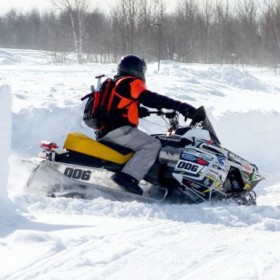One important part of the Clean Snowmobile Challenge that we host each year is the emissions testing. The Michigan Tech team, as well as the others, has to make sure their sled is performing within certain standards.
It’s important to the competition, accounting for more than 20 percent of the total score.
Matt Chmielewski, applications engineer of AVL Testing System, administers the lab emissions and in-service emissions testing.
“The lab simulates the trail riding of the sleds, and we also supply the equipment that measures emissions right from the tailpipe,” Chmielewski says. “We test sleds throughout the week, once they complete the endurance run.”
It’s the fifth year Chmielewski has been involved, and he appreciates the interactions with students.
“We can expose them to type of equipment they might be working on,” he says. “And we want to know what they think of our equipment.”
He’s seen improvements in lowering emissions over the years, too.
“In just a few years, it’s been significant,” he says. “They routinely do well with the testing.”
During the week, Chmielewski was busy setting up the lab and fitting a test sled with an exhaust hood out the back and two important features up front.
It has a water-break dyno and throttle actuator to simulate on-trail conditions,” he says. “We control it all through software and designate discrete points to ramp up and down to. The test we are running this year is optional for the EPA regulations, but we want to challenge the teams to hit them.”
Changing fuels have been a challenge for the teams, too. The ethanol blend has given way to isobutanol this year, which will be easier to calibrate for, Chmielewski said. And ethanol could have troubles in cold weather, whereas iso-butanol does not.
The whole test set-up is pretty impressive. It’s a long way from where they were.
“Would you believe we used to have to stand next to it with a laptop and control the dyno and the throttle all at the same time?” he says.
A couple of days later, teams of students were huddled around their machines in the main garage. We caught up with the Kettering University team that was prepping their fuel lines for the in-service emissions event. At one point, they used a cellphone light to illuminate their work.
On the emissions test course, Scott Miers ’95, assistant professor of ME-EM, was putting sleds through the paces. His inclination at how isobutanol would affect the operation of the snowmobiles was “no significant difference,” based on previous research and the levels of isobutanol being tested.
“The impact of these alternative fuels has a lot to do with the octane of the fuel and the energy density,” he says. “Ethanol has a higher octane but a lower energy density compared to butanol. Perhaps a mixture of fuels could produce a final product with excellent properties across the board.”
He’s been running emissions testing here for over five years, and on this sunny, windy, 16-degree day, he rode the Kettering sled on the course without issue.
He ran the Kettering sled in economy mode while varying the speed from 20 mph up to 45 mph and navigating the machine around a 1.3 mile test course on the KRC property. That was roughly 25 percent throttle one of the Kettering teammates said.
Miers takes four laps around the test course pulling the aluminum-frame test rig he put together with an undergraduate ME student and KRC staff . The snowmobile exhaust was sampled using a ten-foot heated hose connected to portable emissions analyzer. The rig also contains a fuel-measurement system that calculates exhaust emissions in grams/mile, identical to emissions analysis reported for automobiles.
“It’s half the weight of the old one, reducing weight from over 500 pounds to right around 250,” he says of the sled. And it features a clear polycarbonate cover that is placed on the rig during the testing to keep snow and ice out of the measurement systems.
“The teams have shown up prepared for the in-service emissions event and pollutant levels are down again this year, which is exciting to see,” Miers says. He really enjoys showing the teams their data, minutes after collecting it and discussing the technical details with team members. “It’s one of the main reasons I do this year after year—to interact with the students and see their excitement and enthusiasm for their snowmobile design.”
The numbers gleaned from the test were then amassed on a laptop nearby. After getting the thumbs-up that they were all there, the Kettering gang was free to return to the shop with their sled.
More fine tuning would be the order of the day before the next challenges awaiting them. The whole scene is an engineer’s dream: high-tech problems to solve; seemingly constant challenges, some low-tech, to overcome; and an incredible network of university, corporate, and volunteers working together. It’s a challenge just to pull it off.
Update: Their hard work paid off: Kettering was the overall internal combustion winner for the first time. SUNY Buffalo captured the Sensors Inc. Award for Lowest In-Service Emissions and the AVL Award for Best Emissions with its biodiesel-powered snowmobile. Michigan Tech won the award for sportsmanship: no surprise there. The results appear under At Tech, below.
Dennis ’92 ’09
Snowfall Totals
5o degrees on Monday, 10 on Wednesday. Our Keweenaw . . .
Keweenaw County numbers.
Keweenaw Research Center totals.

